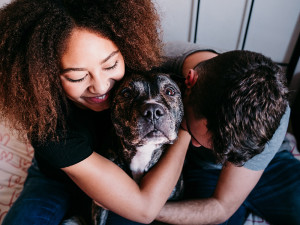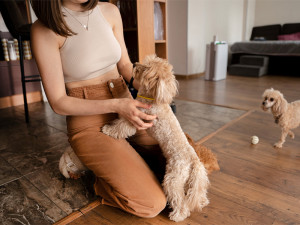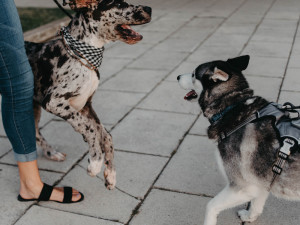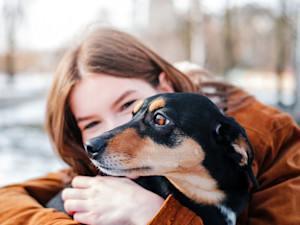6 Ways Your Dog Is Signaling They Want to Play—Right Now
Your dog knows when they want fun and games, but it’s important you understand. Here’s why.
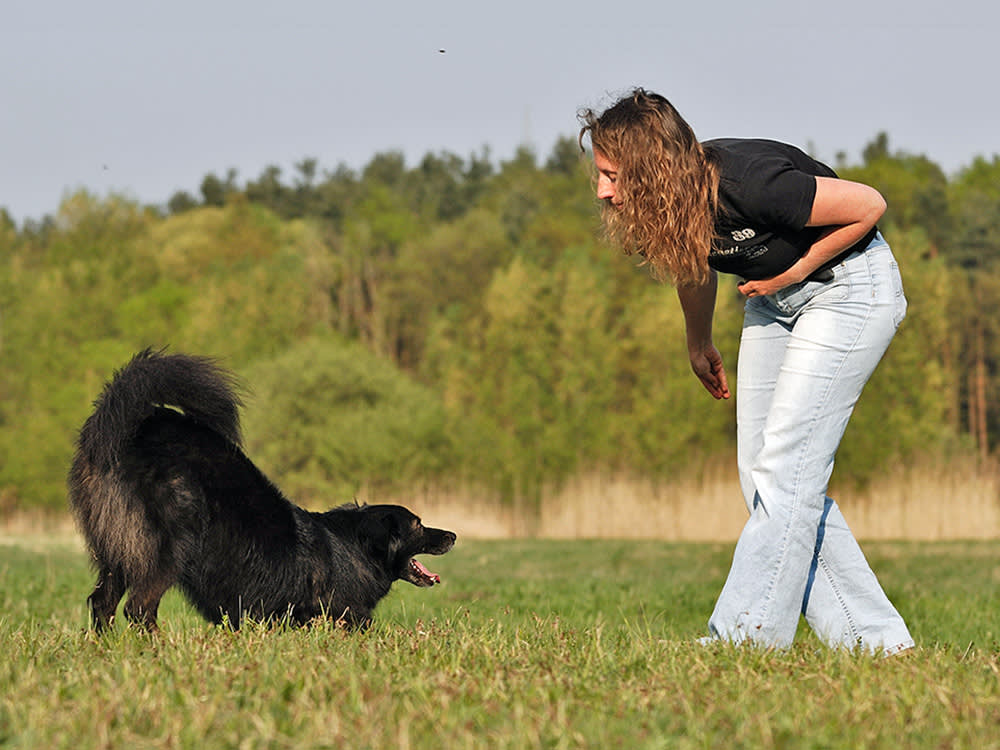
Share Article
Your dog bites at the foreleg of another dog at the park. Aggression? No, it’s very likely playful. A dog’s mouth is open, and they appear to be grinning. Plotting an attack? Nope, once again, it’s far more likely to be playful.
One dog is batting at another dog with their paws. Did they confuse this event with a boxing match? Not at all, because using their paws like this is a really common way to get play going with other pups. Elbows on the ground, behind up in the air, tail actively engaged? Having a good stretch? Well, however much it may resemble a stretch, in this context, it is almost surely playful. You may know that’s a play bow, but humans don’t understand most other play signals very well—whether our dog is displaying them for us or another dog. That’s unfortunate, because if we did, we would understand our pets so much better.
The idea of a play signal — a behavior that requests play from a potential playmate or indicates that play is coming, is a great one. I mean, seriously, how great is it to have a way to communicate that you want to play and to invite someone to join? The following behaviors are good signs that your dog wants you to understand that they want the games to begin.
Play bow
The play bow is the best-known play signal and universally recognizable. This behavior consists of a dog placing their elbows and lower part of their forelegs on the ground while their back end stays up. The back often curves, the tail is frequently in a high position and wagging, and the forelegs are often turned out to form a “V,” rather than being parallel to each other.

Play bows frequently occur before dogs begin to play, and they also occur in between bouts of play, perhaps to ease tensions, make a hesitant dog more comfortable, or to keep play going longer. People can perform play bows to start play with their dogs, or even do a standing human version in which we bend our knees suddenly or even sort of hop into a partial squat and spread our arms out in a low V.
Play face
There’s a particular facial expression that is considered an invitation to play, and it is not unique to dogs; in fact, it is called the “mammalian play face.” It’s seen in many animals including canids and primates, and it was first described by Charles Darwin. In this expression, dogs have relaxed facial muscles, an open mouth that looks similar to a smile with slightly open jaws, and the lips pulled back sideways (not vertically).
Gently biting front paw of playmate
Dogs often initiate play by biting the front paw of a potential playmate. They don’t bite hard in this context but rather in a controlled, inhibited, gentle way. Many dogs respond to this play initiation attempt positively by mouthing back at the other dog, or starting to play with chasing or wrestling.
Many humans become alarmed when a dog mouths at their arm and become angry or scared, and that’s why this play signal is not generally effective at initiating play with people. I prefer not to respond to this behavior by a dog with play because I generally like when dogs avoid having their teeth on my skin.
Batting at a playmate with a paw
Boxing or batting their front paws at a potential playmate is a common way to signal an interest in play. The play may continue with a lot of paw action or morph into another kind of play — wrestling, chasing, body slamming, or mouthing at each other’s faces. Some dogs commonly use this signal at the start of play but others don’t.
Even dogs who don’t bat their paws at others tend to understand the meaning of this behavior. Most humans don’t, though, and that leads to a common communication failure between people and dogs. If a dog leaps up at a person, and the person attempts to stop this behavior by pushing the dog down with their hands, many dogs interpret this as a play signal and get even more jumpy and bouncy.
This often results in a person pushing at the dog but getting annoyed that the dog keeps jumping. Then, the dog will keep jumping, only to be confused and heartbroken that they’re being yelled at or grabbed roughly by the person. The poor dog! They understandably think the person wants to play but then become alarmed when the person seems angry with them for trying to play, too.
Rolling over (in a particular way)
Another play signal involves a dog lowering themselves close to the ground and twisting their upper body so they are partly on their back with one shoulder, and then the other lands on the ground. They end up going belly-up just a split second later, right near the head of another dog. Sometimes after they roll over in this way, they then either bat their paws at the face of the other dog or give a very inhibited bite to the dog’s front paws.
Initiating play without formal signals
Sometimes, dogs act in a particular way that seems to get play going, but they aren’t technically showing play signals. In these instances, it’s not so much that they are communicating their desire to play or assuring another dog that what follows is playful in nature, but rather they just act playful, and then the other dog joins in.
One way of initiating play without a formal play signal is to start a chase. A dog can do this either by running toward or away from the other dog. Here are some playful communications: If the dog runs in circles around the other dog; if they run with bouncy movements that are unlike the way dogs run when they are serious (serious meaning either running in the opposite direction to get away or running toward the other dog to attack); or they approach and then retreat from the other dog multiple times.
Another way that a dog can entice another dog to play is to hold a toy and wave it about near that pup or calmly approach and offer them one end of a toy that can be used to play tug. If the other dog takes one end of the toy in their mouth, the first dog may wait a beat to make sure the other dog has a good grip on the toy and then begin to pull in earnest. In each of these cases, the playful intentions were obvious, and that’s important for avoiding misunderstandings.
Skipping play signals
Play signals are essential in most cases but are sometimes skipped among regular playmates, especially within a household. Dogs who play together regularly, especially if they live together or see each other every day, sometimes don’t bother with play signals. It seems it is just assumed that the behavior is playful so there is no need to “say” so explicitly. It’s much like human siblings who suddenly leap out at each other to surprise or scare each other or suddenly start to wrestle — everyone understands that nobody is being attacked and that this apparently rough or aggressive behavior is actually playful. There’s no confusion because it is clearly intended to be in good fun.
The trouble comes when people who are used to skipping play signals with close friends or family members act the same way with other people, who don’t understand they are just playing. The person on the receiving end can become startled or alarmed. A person might jump onto their brother’s back unexpectedly, leading to a laugh and some wrestling, but if that same person jumps on the back of a random stranger, the response may be a fight, even if the leaper had playful intentions.
The same is true for dogs. They may be able to charge at and start wrestling with their best buddy, as they have done many times with everyone having fun. However, charging at and starting to wrestle with an unknown dog can lead to real trouble. The other dog might naturally seek to defend themselves from what they perceive as an attack.
In praise of play signals
Dogs are good at initiating play, and a big part of their process is using play signals to communicate that play is the plan. Let the games begin!

Karen B. London, PhD, CAAB, CPDT-KA
Karen B. London is a certified applied animal behaviorist (CAAB) and certified professional dog trainer (CPDT) who specializes in working with dogs with serious behavioral issues, including aggression. She has written for a variety of magazines including The Bark, Clean Run, and the APDT Chronicle of the Dog, and has published in scientific journals including Behavioral Ecology and Sociobiology, Ethology, Ecology, and Evolution, the Journal of Insect Behavior, and Insectes Sociaux. She is the author of seven books about dog training and canine behavior, including the forthcoming My Dog's Mystery Adventure: And Other Stories From a Canine Behaviorist and Dog Trainer.
Related articles
![Illustration of a woman hugging a dog]()
Your Dog Can Smell When You’re Stressed, New Study Says
Research finds that your pup can smell when you’ve been doom-scrolling, and they get bummed out.
![A woman sitting on a floor playing with her dogs.]()
How to Know if Your Dog Has Imprinted on You
If they’re following you around like your shadow, there’s a reason for that.
![Great Dane puppy and Husky meeting on leash out side.]()
Understanding Reactivity and Aggression in Dogs: Two Very Different Things
Turns out, even experts have a hard time defining these terms.
![Woman holding her scared dog outside.]()
5 Surprising Things That Dogs Are Afraid Of
And what to do when they go careening away from the Roomba.
![Tired millennial woman sleeps on sofa with her dog.]()
Dogs Stay Up Worrying at Night Too, Study Says
It may happen more when there stressful events like fireworks.
![Dog laying on the ground guarding toy in mouth]()
How to Get Your Dog to Stop Resource Guarding Their Stuff
If your dog growls when you get near their food or toys, read this right now.

